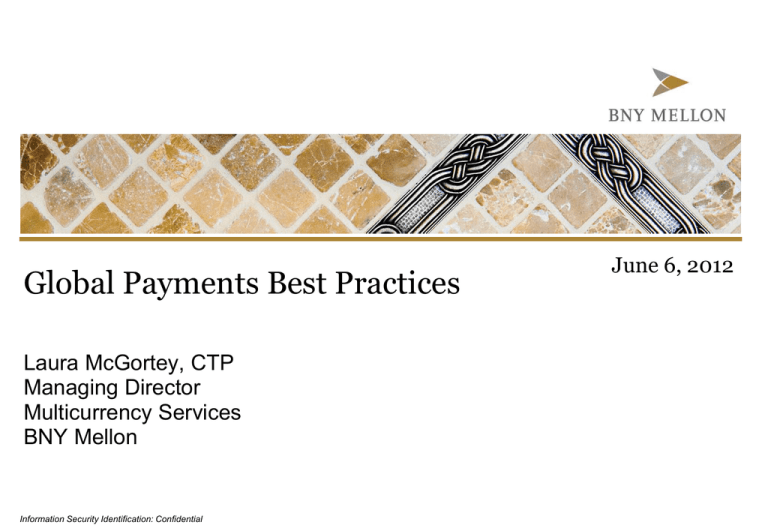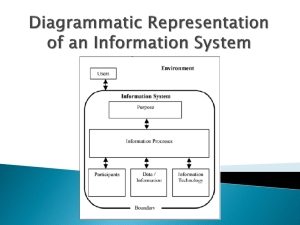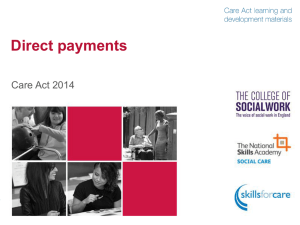
Global Payments Best Practices
Laura McGortey, CTP
Managing Director
Multicurrency Services
BNY Mellon
Information Security Identification: Confidential
June 6, 2012
Key Topics
•
What in the World is Going On?
•
Regulatory Considerations
•
Payment Systems and Charging Options
•
Options for Managing Global Payments
2 Information Security Identification: Confidential
What in the World is Going on?
What are your international cross-border payment pain points?
• Cost
• Beneficiary never receives full value
• Delivery is often late
• Multiple global payment providers, inconsistent reporting
• Other?
3 Information Security Identification: Confidential
Regulatory Considerations
The theme is transparency; for example:
US – Dodd Frank:
• Payments from consumers’ US-based accounts to any beneficiary outside the US
• Sweeping requirements for full transparency regarding FX rate, settlement date,
local taxes, any fees – prior to transaction initiation
• Infrastructure challenges
Europe:
• Payment Services Directive (PSD)
• Provides fee transparency for intra-Euro zone payments, no deductions or lifting
fees
4 Information Security Identification: Confidential
Payment Systems
There are many different Payment Systems—each best suited for certain types of
transactions
Payment System
Typically Used For
Examples
ACH, IACH or local low value
bulk
High volume, low value
US – ACH
Europe – PeACH, SEPA Debit or
Credit (aka EBA Step2)
UK – BACS, Faster Payments
China – BEPS
India - NEFT
Consumer or commercial
payments
Wire (RTGS – real time gross
settlement)
Low volume, high value
Consumer, commercial or
wholesale
Wire (RTNS – real time net
settlement)
Low volume, high value
Consumer, commercial or
wholesale
5 Information Security Identification: Confidential
US – Fedwire
Europe – Target2
UK – CHAPS
Hong Kong – CHATS
China - CNAPS
US – CHIPS
Europe – EBA EUR01 or Step1
Types of Payments
Payment types:
• Accounts Payable: Can be ad hoc or recurring, remittance data is very important as is
payment in full (limited lifting fees or deductions)
• Payroll, Pension: Repetitive, pre-planned; therefore real time payment systems not
required, limited need for remittance data
• Intracompany Payments: Time sensitive, high value
• Consumer Remittances: Often time sensitive, low value
6 Information Security Identification: Confidential
Considerations Regarding Payment Systems
Wire (Funds Transfer, RTGS, RTNS, etc)
• Beneficiary Deductions are common
• Options for paying in full (Full Pay, OUR) can be expensive
• Most often used for Accounts Payable, Intracompany Payments, Financial
Settlements, Consumer Remittances
ACH or IACH
• Not available to all areas
• Local low-value bulk clearing systems are not interoperable and do not ‘talk’ with
each other
• Payment services providers may offer solutions for streamlining and accessing
these platforms
• Limited remittance data
• Most often used for Payroll, Pension, Accounts Payable (where extended
remittance data is supported)
• Often supports “payment in full” schemes with less cost to the remitter than Wire
payments
7 Information Security Identification: Confidential
Important Considerations Regarding Charge Types
Charge Indicator (SWIFT field 71 or Fedwire 6100)
Utilized for cross border payments outside the US
BEN
SHA
OUR
Charge Indicator
How Charged?
Deduct from the principal
of the transaction
Varies per market –
sometimes treated as
BEN, sometimes limits to
only explicit transaction
fees for the sender and
receiver
The initial sending bank
Who Charges?
Any bank in the payment
‘chain’
Initial sending bank
charges remitter;
beneficiary bank charges
receiver
All banks in the ‘chain’
What is Charged?
Various amounts can be
flat or percent
Amounts can vary however
must be disclosed
Various amounts can be
flat or percent
Key Considerations
Multiple deductions are
possible based on how
many Financial Institutions
‘touch’ the payment
Typically payments are
only treated as SHA in
certain regulated markets
(e.g., within the EU, within
the US, etc).
Multiple charges can be
received per transaction.
Sending bank must cover
costs therefore a costly
payment option for the
remitter
8 Information Security Identification: Confidential
How Many Parties Might be Involved in Your Cross
Border Wire Payment?
ABC Co.
Sending Bank
Sending
Bank’s
Correspondent
Bank
Central Bank –
RTGS clearing
– local market
Beneficiary
Bank’s
Correspondent
Bank
Beneficiary
Bank
XYZ Ltd.
Number of parties expands opportunity for lifting fees and deductions.
Be certain to know how your bank or payment services provider is
handling charge indicators and lifting fees.
9 Information Security Identification: Confidential
Options for Managing Global Payments
Local Accounts
• Process payments from company owned currency accounts
• Accounts may be centralized and managed from one location or localized and managed by local
staff
• Payment initiation and data reporting may require access to various electronic banking platforms
• Can be costly to manage, reconcile
Centralized Account
• Account may be localized or centralized
• One account, one currency to fund all payments, to all locations, all currencies
• Streamlines management via one payment portal and consolidated reporting
• Access to multiple payment types
• Often there is more flexibility regarding charging options including easier access to “payment in
full” type services
10 Information Security Identification: Confidential
Example of a Centralized Account Payments Portal
11 Information Security Identification: Confidential
This presentation is intended to provide a general overview of our services and is not an offering or commitment to provide any credit facilities or services.
12 Information Security Identification: Confidential
©2012 The Bank of New York Mellon Corporation. All rights reserved.








